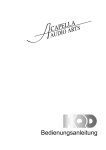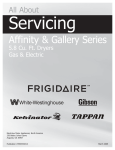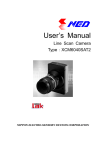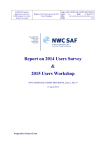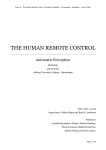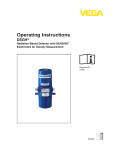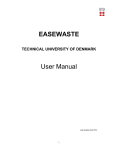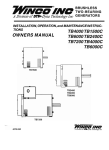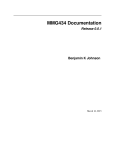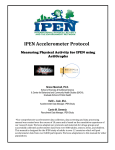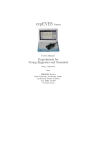Download Application Note
Transcript
DANBRIDGE A/S Reliability Testing of Nominally Linear Components by Measuring Third Harmonic Distortion CLT 10 Component Linearity Test Equipment Application Note Danbridge A/S Copyright 2002 Danbridge a/s All rights reserved. No part of this publication may be reproduced or distributed in any form or by any means without prior consent in writing from Danbridge a/s 5 Hirsemarken DK-3520 Farum Denmark Phone no.: +45 4495 5522 Fax no.: +45 4495 4504 Email: [email protected] Web: www.danbridge.com CLT 10 Contents Table of Contents Section Page 1. Introduction ................................................................... 1 1.1 1.2 The Contents of this Application Note ............................................. 1 Overview and Features.................................................................... 1 2. Principle of Operation ................................................... 3 2.1 2.2 2.3 2.4 2.5 Measurement Principle .................................................................... 3 Detection of Unreliable Components............................................... 5 Description of the CLT 10................................................................ 6 Operation at a Glance ..................................................................... 8 General on Impedances .................................................................. 8 3. Hints about Operation................................................. 11 3.1 3.2 3.3 3.4 Manual Operation .......................................................................... 11 The IEC Set-up.............................................................................. 13 Selecting the Correct Range.......................................................... 14 Choice of measurement bandwidth ............................................... 14 4. Testing Resistors ........................................................ 17 4.1 4.4 Metal-film Resistors ....................................................................... 17 4.1.1 Non-linearity in Resistive Materials .......................... 17 4.1.2 Defects in Resistance Tracks and Connections....... 18 4.1.3 Temperature Coefficient........................................... 18 Resistor Networks.......................................................................... 19 Calculating Distortion..................................................................... 20 4.3.1 Constriction .............................................................. 20 4.3.2 Length of Resistance Track...................................... 21 4.3.3 Third Harmonic Index, THI ....................................... 22 Low-distortion Resistors ................................................................ 22 5. Testing Capacitors ...................................................... 25 5.1 5.2 5.3 Electrolytic Capacitors ................................................................... 25 Foil Capacitors............................................................................... 26 Ceramic Capacitors ....................................................................... 27 6. Testing Other Types of Components ......................... 29 6.1 6.2 6.3 Inductors........................................................................................ 29 PTC Resistors with Hidden Cracks................................................ 29 Bad Solderings in Loudspeakers ................................................... 30 4.2 4.3 CLT 10 App. Note Danbridge A/S i CLT 10 Contents 7. Production Line Integration ........................................ 31 7.1 7.2 7.3 7.4 7.5 7.6 Triggering the CLT 10.................................................................... 31 Timing............................................................................................ 31 Measurement Jigs ......................................................................... 33 Resistors and Resistor Networks................................................... 34 Data Retrieval................................................................................ 35 Noise Considerations .................................................................... 35 8. Literature References.................................................. 37 9. Index ............................................................................. 39 10. Miscellaneous .............................................................. 43 10.1 Document Status Record .............................................................. 43 10.2 Terms and Abbreviations............................................................... 44 ii CLT 10 App. Note CLT 10 List of Figures List of Figures Figure Fig. 2.1 Fig. 2.2 Fig. 2.3 Fig. 2.4 Fig. 4.1 Fig. 4.2 Fig. 5.1 Fig. 5.2 Page Principle of Operation ........................................................... Typical Distribution of Distortion in a Batch of Components . Distortion in a Batch of Components Plotted on Probability Paper................................................................... Outline of the CLT 10 system ............................................... Third Harmonic Distortion as a Function of the Temperature Coefficient in a Metal-film Resistor........................................ A Spiralled Resistor with a Constriction in the Resistance Track .................................................................. Schematic Diagram of a Capacitor with an AC Current ........ Timing Diagram..................................................................... CLT 10 App. Note Danbridge A/S 3 4 5 6 18 20 26 32 iii CLT 10 Danbridge a/s This page is intentionally left blank. iv CLT 10 App. Note Section 1 Introduction 1. Introduction 1.1 The Contents of this Application Note This application note contains application specific information on the CLT 10 Component Linearity Test Equipment consisting of the CLT 10 Control Unit (391-080) and the CLT 10 Measuring Unit (391-081). Please refer to the Operator Manual for each of these two units for general instructions on installation. The contents of this application note are as follows: Section 1 Section 2 Section 3 Section 4 Section 5 Section 6 Section 7 Section 8 Section 9 Section 10 1.2 General introduction (this section). A primer to the measurement principle and an overview of the operation of the CLT 10. A guide to the operation of the CLT 10 dealing with both manual and IEC 440 operation including two examples. General information on measurements of distortion in resistors. General information on measurements of distortion in different types of capacitors. Other types of components including inductors are discussed in this section. Information on system integration on production Lines. Bibliography. The Index of this application note. Miscellaneous information including a document status report and abbreviations. Overview and Features The CLT 10 Component Linearity Test Equipment is used for reliability testing of passive electronic components. The CLT 10 performs a measurement of the third harmonic distortion of the component under test, and it can subsequently determine whether to reject the component or not on basis of this measurement. The system consists of the CLT 10 Measuring Unit and CLT 10 Control Unit which are interconnected through a fiber optic link. In this application note it is assumed that the installation instructions of these two units are followed. Please refer to the instructions in each of the Operator Manuals for the two units. CLT 10 App. Note Danbridge A/S 1 Section 1 Introduction The measuring method of the CLT 10 offers a number of advantages compared to other methods of reliability testing. One important feature is the measurement speed which facilitates 100 % production test. Although the CLT 10 can be used for testing of all types of passive components, the main application of the CLT 10 is testing of resistors. The CLT 10 features computerized control of all functions which opens for a broad range of system integration and statistical analysis. Please refer to the Operator Manual for the CLT 10 Control Unit for detailed programming information. This application note contains a variety of technical and application specific information for the convenience of the user. The key features of the CLT 10 are: • • • • • • • • • • Impedance range from less than 100 Ω to more than 3 MΩ 10 kHz voltage up to 1 kV Third harmonic below -160 dB Power up to 4 VA More than 30 components per second IEEE 488 interface, RS-232-C interface and a versatile Measuring Unit interface The measurement voltage can be controlled externally Insensitive to external magnetic fields Easy IEC 440 set-up Programmable rejection limits The system's application is very broad and includes: • • • • • 2 Production testing Component development Acceptance testing Investigation of non-linearity in materials Screening of audio-grade components CLT 10 App. Note Section 2 Principle of Operation 2. Principle of Operation 2.1 Measurement Principle In the CLT 10 the non-linearity of the component under test is determined by a measurement of the third harmonic distortion generated by the component when a purely sinusoidal signal is applied to it. The CLT 10 Measuring Unit is able to supply the component under test with a 10 kHz signal with very low harmonic contents, and it is able to measure the level selectively of the 30 kHz signal generated by the component. Fig. 2.1 - Principle of Operation If the impedance of the component is not absolutely independent of the applied voltage, the sinewave current will be distorted. In other words, the current consists of a pure, fundamental sinewave component (10 kHz) and higher harmonics. As the third harmonic component (30 kHz) is the dominant one, this is chosen as a measure of the distortion or, as it is also called, the non-linearity of the impedance of the component. Electrically, the third harmonic current is equivalent to a no-load voltage V3,0 in series with the component under test which has an impedance Zx. As the 10 kHz low-pass filter blocks for the 30 kHz signal, the third harmonic voltage V3 is measured over the load impedance R1. Knowing the values of Zx and R1, the no-load voltage can easily be found as: CLT 10 App. Note Danbridge A/S 3 Section 2 Principle of Operation The Measuring Unit contains the circuitry for making the measurement, but the choice of parameters and the timing of the measurement are controlled by the CLT 10 Control Unit. When measuring on a batch of components with nominally the same impedance value, the third harmonic value is found to be distributed around a mean value, see Fig. 2.2. The distribution is Gaussian. A few of the components may, however, exhibit a higher distortion than that of the rest of the batch due to small defects or deviations in the material composition. When exposing the batch to an accelerated life test, the components having a high degree of distortion will also be prone to exhibit inferior reliability. Fig. 2.2 - Typical Distribution of Distortion in a Batch of Components Some components contain materials which inherently have a high distortion: Magnetic materials, composition resistors, high-dielectric capacitors etc. In these components, the excessive distortion from a small defect is hidden in the high inherent distortion and cannot readily be detected. At the other end of the scale, we have metal-film resistors where the inherent distortion is very low, typically -130 dB or lower, and the wire-wound types which normally exhibit even lower distortion. With these components, defects give rise to a distortion which normally exceeds that of the rest of the batch. When an electric current flows through a conductive element, it can be shown that the generated harmonic voltage follows the equation: V3,0 4 I = k3 ⋅l ⋅ 1 A n CLT 10 App. Note Section 2 Principle of Operation I1 is the 10 kHz current, A is the area of the conductor, l is the length of the conductor and k3 is a material constant. For resistive elements, the exponent n is close to 3. If a conductor has a constriction, for example due to a flaw in the track, the area A will decrease locally, and consequently the third harmonic voltage for the defective part of the conductor increases by the third order of magnitude. Even if the length of the constriction is short, the increase in the third harmonic is often high enough to reveal itself as an increase in the total distortion of the component. A constriction may also occur in contacts if the conduction only takes place over a fraction of the conductive surface (bad soldering for instance). 2.2 Detection of Unreliable Components The actual value of the distortion in a good component must be found experimentally. The distortion of the components, which may be unreliable, is found by selecting the components which have a higher distortion than the rest of the batch. Sometimes the defective components have a distortion much higher than that of the rest of the batch. At other times, it may be more difficult to determine the rejection limit. In such cases, it is useful to plot the third harmonic values on probability paper as shown in Fig. 2.3. CLT 10 App. Note Danbridge A/S 5 Section 2 Principle of Operation Ideal Distribution Fig. 2.3 - Distortion in a Batch of Components Plotted on Probability Paper A straight line in Fig. 2.3 corresponds to a Gaussian distribution. If part of a batch deviates from the straight line, it should be rejected and subjected to a further study. The study could consist of an accelerated life test in which some of the accepted components take part as well for comparison. With respect to resistors and ceramic capacitors, the failure can often be seen under microscope after the coating has been removed chemically. 2.3 Description of the CLT 10 The CLT 10 Component Linearity Test Equipment consists of two units: The CLT 10 Control Unit and the CLT 10 Measuring Unit. Each of these two units are described briefly in this section. The Control Unit is divided into the CPU board and the display part, which also holds the keyboard. The CLT 10 Measuring Unit can be divided into a generator part, which takes care of the generation of the 10 kHz signal, and a voltmeter part, which selectively measures the third harmonic level around 30 kHz. As a third part 6 CLT 10 App. Note Section 2 Principle of Operation we find the interface system and the power supplies, which serve both the generator and voltmeter parts. The division between the generator part and the voltmeter part is very distinctive in the CLT 10 Measuring Unit in order to get a proper grounding and a low self-induced signal deterioration. Furthermore, the communication between the CLT 10 Measuring Unit and Control Unit is based on optical fibers, which makes the system reliable in noisy environments. The following diagram of the structure of the CLT 10 Measuring Unit and Control Unit shows the division between the generator and voltmeter parts. Fig. 2.4 - Outline of the CLT 10 System The AGC/Generator generates a 10 kHz sinewave signal with a level determined by the Interface Board which communicates with the CLT 10 Control Unit. The 10 kHz Power Amplifier amplifies the signal from the AGC/Generator in order to get sufficient level and in order to achieve the desired current capability. The Low-Pass Filter attenuates the contents around 30 kHz in the signal from the Power Amplifier in order to get a sufficiently low 30 kHz residual level. The output impedance of the Low-Pass Filter is high at 30 kHz. The High-Pass Filter has a high impedance at 10 kHz and it is constructed so that the distortion is very low at that frequency. The 30 kHz Voltmeter measures selectively the level at 30 kHz on the output of the High-Pass Filter. The impedances of the High-Pass and Low-Pass Filters ensure that the energy at 30 kHz generated in the component under test is led to the voltmeter and not to the Power Amplifier. CLT 10 App. Note Danbridge A/S 7 Section 2 Principle of Operation By means of the Matching Transformer it is ensured that the available power can be supplied to the Device Under Test throughout a wide impedance range. At the same time, the Matching Transformer ensures matching of the third harmonic voltage to the High-Pass Filter. Based on patented circuitry the transformer is made transparent at 10 kHz and at 30 kHz, and consequently, both low noise in the 30 kHz Voltmeter and optimal working conditions for the Power Amplifier are ensured. The input impedance of the 30 kHz Voltmeter can be changed in order to get 1 kΩ or 100 Ω impedance at 30 kHz seen on the input terminals of the HighPass Filter. When the Matching Transformer is inserted these impedances are increased 100 times which in total gives 4 different impedances at 30 kHz as seen on the measurement terminals: 100 Ω, 1 kΩ, 10 kΩ and 100 kΩ. The AGC/Generator, the Power Amplifier and the Low-Pass Filter form an AGC-loop: The AGC/Generator capacitively senses the level of the 10 kHz signal on the output terminals, and adjusts the level as set by a control signal from the Interface Board. At the same time the Interface Board sets the parameters of the 30 kHz Voltmeter. By controlling both the settings in the 10 kHz generator system and in the voltmeter while receiving data from these boards, the Interface Board serves as link between the Measuring Unit and the Control Unit and hence the user. Please consult the Service Manual for the CLT 10 Measuring Unit Service Manual for a detailed description of each of the parts of the Measuring Unit. 2.4 Operation at a Glance The CLT 10 can be operated both manually and automatically. Various features of the CLT 10 make the operation easier, and fill the gap between manual and automatic operation: • • • • Set-up according to IEC 440 Autoranging of the 30 kHz Voltmeter Set-ups can be stored Programmable rejection limits On both the production line and in the laboratory the following basic steps are found: Find the impedance at 10 kHz of the component to be tested. Find the impedance at 30 kHz of the component to be tested. Select the impedance range of the CLT 10 based on the impedance at 30 kHz 8 CLT 10 App. Note Section 2 Principle of Operation Set up the 10 kHz Generator so the desired power is delivered into the impedance at 10 kHz. The limits of the CLT 10 should be observed. In case of resistors the IEC 440 set-up can be used. Connect the component to be tested to the measuring terminals. Switch the 10 kHz voltage on. Select a suitable range of the 30 kHz Voltmeter. The autoranging could be used. Calculate the distortion. The dB setting of the 30 kHz Voltmeter could be used. If needed, the corrected distortion level can be found. If the IEC 440 setup has been used, this is done automatically. Automatic operation on a production line differs from manual operation only by the introduction of triggering and the involved timing. In addition, several programming features are implemented in the CLT 10. Please refer to the Operator Manual for the CLT 10 Control Unit for detailed programming information. 2.5 General on Impedances The impedance of a resistor is the same at 10 kHz and at 30 kHz. Nonresistive components have different impedances at different frequencies. The impedance of a capacitor decreases with increasing frequency: ZC = 1 2π ⋅ f ⋅ C where f is the frequency and C is the capacitance. The impedance of an inductor increases with increasing frequency: Z L = 2π ⋅ f ⋅ L where L is the inductance. In general, the impedance of an unknown component should be measured by an impedance meter at 10 kHz and 30 kHz. Measurements on components near resonance for instance can give misleading results if the impedance at one frequency merely is calculated from the impedance at another frequency. It is the impedance at 10 kHz of the component which determines the load of the CLT 10 and the power delivered to the component under test, but it is the impedance at 30 kHz of the component which sets the correction factor: CLT 10 App. Note Danbridge A/S 9 Section 2 Principle of Operation FC = 1 + ZX R1 where ZX is the impedance of the component under test at 30 kHz, and R1 is the input impedance of the CLT 10 at 30 kHz. In case of resistive components the correction factor is simplified to: R FC = 1 + X R1 The no-load third harmonic voltage is reduced by the factor FC, and thus the corrected non-linearity in dB is expressed as: D C = D + 20 ⋅ logFC where D is the measured distortion in dB. The Corrected Residual NonLinearity (CRNL) is calculated from the Residual Non-Linearity (RNL) in the same manner: CRNL = RNL + 20 ⋅ logFC 10 CLT 10 App. Note Section 2 Principle of Operation This page is intentionally left blank CLT 10 App. Note Danbridge A/S 11 Section 3 3. Hints Hints about Operation A detailed description of the operation of the CLT 10 is found in the Operator Manuals for the CLT 10 Measuring Unit and the CLT 10 Control Unit. The user is advised to get acquainted with these two manuals before operating the CLT 10. This section covers additional information related to the operation and cannot substitute the Operator Manuals. Component specific information is found in sections 4, 5 and 6 while information about integration on production lines is found in section 7. 3.1 Manual Operation Basically, the steps in subsection 2.4 are followed when operating the CLT 10 manually. Additional application information about manual operation is given in this subsection: - Find the impedance at 10 kHz and at 30 kHz of the component to be tested. Select the impedance range of the CLT 10 based on the impedance at 30 kHz. The comments on impedances in subsections 2.5 and 3.4 and in sections 5 and 6 should be observed. Set up the 10 kHz Generator so the desired power is delivered into the impedance at 10 kHz. If the impedance is complex, the numeric value at 10 kHz should be used. The CLT 10 can deliver 0.25 W throughout the nominal 100 Ω - 3 MΩ impedance range, but more than 4 W in certain ranges. Observe the limits of the CLT 10 as indicated in the Operator Manual for the CLT 10 Measuring Unit. In the upper impedance range the Cable Unit must be used in order to get impedance matching and thus correct measurements. In case of resistors the IEC 440 set-up can be used. This set-up sets the 10 kHz Generator and impedance range based on the chosen impedance and power level. At the same time, the corrected distortion is calculated on the basis of the chosen impedance. If the component is non-ohmic, the calculated distortion may be erroneous. - Connect the component to be tested to the measuring terminals and switch the 10 kHz voltage on. It is important that the terminals are tightened properly in order to achieve low residual distortion. In case the Cable Unit is used, all four terminals have to be tightened properly. Please observe that the 10 kHz signal could be hazardous! For safety reasons, the measuring terminals must not be touched when the MV ON indicator is lit. Even at low 10 kHz voltages the terminals must not be 12 CLT 10 App. Note Section 3 Hints touched during the measurements, as palpation of the terminals mostly leads to excessively high measured distortion. Do not use long laboratory wires or similar to connect the component under test to the CLT 10 as this mostly causes high residual distortion regardless of the wires being twisted or not. Keep metal objects that are not grounded at least 10 cm away from the measurement terminals. In general non-linear materials should be kept at least 10 cm away from the measurement terminals. Even an ordinary pencil can cause distortion when pointed at the hot terminal due to the coupling to the highly non-linear pencil lead! Select a suitable range of the 30 kHz Voltmeter. For best accuracy select the most sensitive range possible. The autoranging could be used. - Calculate the distortion. When the dB setting of the 30 kHz Voltmeter is used, the ratio between the 10 kHz level and the measured 30 kHz level is calculated in dB. The corrected distortion level can be calculated by the formulas in subsection 2.5. If the IEC 440 set-up has been used, this calculation is done automatically. Example Manual measurement of the distortion of a 10 kΩ resistor. The basic steps listed in subsection 2.4 are followed. The impedance at 10 kHz is 10 kΩ, and... The impedance at 30 kHz is 10 kΩ as well. The 3 kΩ - 30 kΩ impedance range of the CLT 10 is chosen as the impedance at 30 kHz is 10 kΩ. If the test power has to be 0.25 W, the 10 kHz voltage is set to 50 V. This power is within limits of the CLT 10 as the available power is more than 1 W at 10 kΩ load impedance. The resistor is connected to the measuring terminals. It is not necessary to use the Cable Unit as the additional measuring error without the Cable Unit in this range and at 10 kΩ component impedance is below 0.1 dB. Switch the 10 kHz voltage on by pressing the MV ON button. Select a the most sensitive range of the 30 kHz Voltmeter without causing overload. The autoranging could be used. Let us assume that the measured 30 kHz voltage is 2.8 µV. Calculate the ratio between the 50 V measuring voltage and the measured 30 kHz voltage. The dB setting of the 30 kHz Voltmeter could be used. In both cases the result is -145 dB. CLT 10 App. Note Danbridge A/S 13 Section 3 Hints In the 3 kΩ - 30 kΩ range the input impedance at 30 kHz is 10 kΩ, and the correction factor is thus 6 dB according to the formulas in subsection 2.5. The corrected distortion is consequently -139 dB. After the test, the measuring voltage is set off. 3.2 The IEC Set-up The IEC 440 standard (literature reference [7]) defines measuring voltages for given resistor values. The CLT 10 can automatically set up the 10 kHz Generator and the impedance range on the basis of the chosen impedance and power level according to IEC 440. At the same time, the corrected distortion is calculated on the basis of the chosen impedance. If the component is non-ohmic, the calculated distortion will be erroneous. The resistance can be entered as either three or four-digit values with the last digit being the multiplier in both cases. The numeric keys of the keyboard are marked with colour bars for convenient entering of resistor values (according to IEC 62). The corresponding entry via the interface is a single string command. Both entry types are shown in the example below: Example The distortion of a 10 kΩ resistor at 0.25 W is measured manually by using the IEC 440 set-up. The basic steps listed in subsection 2.4 are followed. The impedance at 10 kHz is 10 kΩ, and... The impedance at 30 kHz is 10 kΩ as well. It is not necessary to select the impedance range. The 0.25 W mode is chosen by pressing the 1/4W button once. Enter a brown-black-orange-ENTER (1-0-3 = 10 kΩ in E 24) or brown-blackblack-red-ENTER (1-0-0-2 = 10 kΩ in E 192) sequence, and the correct 10 kHz voltage is set automatically. At the same time, the 3 kΩ - 30 kΩ impedance range of the CLT 10 is selected automatically as the resistance is 10 kΩ. The corresponding command for the IEC set-up at 10 kΩ and 0.25 W is "SX,10K,250mW". Please refer to the Operator Manual for the CLT 10 Control Unit for detailed information on operation. The resistor is connected to the measuring terminals. It is not necessary to use the Cable Unit as the additional measuring error without the Cable Unit in this range and at 10 kΩ component impedance is below 0.1 dB. Switch the 10 kHz voltage on by pressing the MV ON button. Select the most sensitive range of the 30 kHz Voltmeter without causing overload. The autoranging could be used. Let us assume that the measured 30 kHz voltage is 2.8 µV. 14 CLT 10 App. Note Section 3 Hints It is not necessary to calculate the ratio between the measuring voltage and the measured 30 kHz voltage when using the IEC set-up as this is done automatically. In this example the result is -145 dB. In the 3 kΩ - 30 kΩ range the input impedance at 30 kHz is 10 kΩ, and the correction factor is thus 6 dB according to the formulas in subsection 2.5. The corrected distortion, which is shown on the display of the 30 kHz Voltmeter, is consequently -139 dB. After the test, the measuring voltage is set off. 3.3 Selecting the Correct Range Normally, the impedance range of the CLT 10 is chosen on the basis of the impedance at 30 kHz of the component under test in order to get the best impedance matching. In case of non-resistive components, however, the impedance of the component at 10 kHz could become too low for the CLT 10. Capacitors exhibit increasing impedance at lower frequencies and the load impedance range of the CLT 10 is therefore not exceeded when the impedance range is chosen on the basis of the impedance at 30 kHz. In case of inductors, on the other hand, or in case of unknown components, the load of the CLT 10 at 10 kHz has to be checked. Coils exhibit decreasing impedance at lower frequencies which dictates that the impedance range of the CLT 10 is chosen on the basis of the impedance at 10 kHz rather than on the basis of the impedance at 30 kHz. In case of resistors the impedance range is chosen directly on the basis of the impedance of the component under test. It would often be advisable, however, to change between the 300 Ω - 3 kΩ range and the 3 kΩ - 30 kΩ range at a resistance of approximately 5 - 6 kΩ rather than 3 kΩ in order to get the lowest CRNL and the highest power capacity. 3.4 Choice of measurement bandwidth The reduction of measurement bandwidth is used for measurement range enhancement. By reducing the bandwidth of the 30 kHz Voltmeter from approx. 400 Hz to approx. 75 Hz the contribution to the Residual NonLinearity (RNL) from broadband noise is reduced. Depending on the relationship between the RNL contributions from broadband noise power (white noise) and narrowband noise power (30 kHz residuals), the reduction of bandwidth gives an improvement of the RNL between 0 and 7 dB. The contributions from broadband and narrowband noise depend on the impedance of the component under test, the chosen impedance range and the type of man-made noise around 30 kHz outside the CLT 10. The narrow bandwidth is primarily used in the most sensitive ranges of the CLT 10. An CLT 10 App. Note Danbridge A/S 15 Section 3 Hints example of application is the measurement on low-distortion resistors as described in subsection 4.4. The bandwidth is chosen either manually or by programming the CLT 10. When pressing the BW button the user can toggle between normal and narrow bandwidth. When the narrow bandwidth is selected the annunciator 'NARROW' is lit. On the interface bus the command BW,ON selects the narrow bandwidth, while the command BW,OFF selects the normal bandwidth. The narrow measuring bandwidth increases the settling time of the 30 kHz Voltmeter, so the bandwidth reduction should not be used in applications where speed is a vital parameter. Please refer to subsection 7.2 for timing information. 16 CLT 10 App. Note Section 3 Hints This page is intentionally left blank. CLT 10 App. Note Danbridge A/S 17 Section 4 4. Testing Resistors Testing Resistors Production testing of resistors, especially metal-film resistors, is by far the most frequent application of the CLT 10. In the following, the types of failures causing distortion in resistors are discussed. 4.1 Metal-film Resistors In summary, the causes of distortion in resistors are: • • • • • • 4.1.1 Non-linearity of the resistive material Defects in the resistance track Poor connections between leads and resistor body Temperature coefficient of the resistor Traces of film left in grooves In-homogeneous spots in the materials Non-linearity in Resistive Materials A wire-wound resistor of a good quality has a third harmonic distortion so low, that it normally is very difficult to detect. The metal-film resistors of today are approaching the same low distortion as that of the wire-wound types. The improvements are widely based on the investigations on resistive materials carried out on the basis of non-linearity measurements. Both accelerated life tests and theoretical studies have shown that a low distortion and a good long-term stability are closely related. A measurement of the distortion can therefore be used to optimize the choice of the metal-film composition, the ceramic material and the metallization process. Experience has shown that failures during the evaporation of the metal-film are clearly revealed as an increase in the distortion. This fact can be used during production to check a small lot of unspiralled resistors for non-linearity. In this way, capping and spiralling of poor resistors can be avoided. In order to compare resistors of different Third Harmonic Index, THI, can be calculated: THI = construction, the V3,0 V1n where V3,0 is the third harmonic no-load voltage, V1 is the applied voltage, and n is an exponent equal or close to 3. The formula shows that for a resistor, it CLT 10 App. Note Danbridge A/S 19 Section 4 Testing Resistors is possible to calculate an index or material constant, which is independent of the applied voltage. The THI is explained in more detail in subsection 4.3. 4.1.2 Defects in Resistance Tracks and Connections As mentioned in subsection 2.1, the generated third harmonic voltage V3,0 is related to the current density of the fundamental current I1: V3,0 I = k3 ⋅l ⋅ 1 A n where A is the area of the conductor, l is the length of the conductor and k3 is a material constant. For resistive elements, the exponent n is close to 3. A failure in the resistor track, due to a failure during the spiralling process or in the ceramic body, usually causes a considerable reduction of the conducting area. Even if the length of the defective track is short, the increase in the distortion with the exponent of 3 is usually sufficient to reveal the failure. If the failure is localized in the contact connection, the contact area is usually considerably reduced. Also, the material in a poor contact may not be purely metallic, and this, in itself, causes a higher distortion. Finally, an even slightly unstable contact produces a distorted current, which is also detected as an increase in the third harmonic voltage. 4.1.3 Temperature Coefficient If the distortion is measured on a batch of resistors, having the same ohmic value but a different temperature coefficient, a curve can be drawn as shown in Fig. 4.1 : Fig. 4.1 - Third Harmonic Distortion as a Function of the Temperature Coefficient in a Metal-film Resistor 20 CLT 10 App. Note Section 4 Testing Resistors The reason for the relation between distortion and temperature coefficient is the varying temperature of the thin metal-film as a function of time and the involved resistance variations; the resistance is modulated with the applied voltage, and the higher the temperature coefficient, the higher the resistance variations and distortion. The temperature variation in the film is in the order of 0.01 to 0.2 °C. If the metal-film resistor for instance has a high positive temperature coefficient, its ohmic value will increase slightly when the applied sinewave is at its maximum voltage value. This will decrease the current compared to that of an ideal resistor of the same value, and the current is therefore distorted. This interesting fact was described in 1974 in literature reference [4]. The curve in Fig. 4.1 can even be drawn based on calculations of the heat transfer from the metal-film. This finding is very important. It means that it is possible to check if the temperature coefficient is within a certain limit, both positive and negative, even on the production line. Especially, when producing metal-film resistors with a very low temperature coefficient, the measurement of the distortion provides the manufacturer with a unique tool to verify at high component rates that both the temperature coefficient and the overall quality are within the specified limits. Metal-film resistors of today's standard often have a temperature coefficient well below 50 ppm/°C. This means that a standard batch of good resistors could have a distortion which on an average is below -140 dB. This, on the other hand, makes the CLT 10 a very sensitive instrument to any inherent failure - whether this is caused by constriction, failure in the material or a too high temperature coefficient. 4.2 Resistor Networks The principles for testing the quality of single metal-film resistors can be applied directly to resistor networks. One example is testing of resistors on substrates. One difference between resistor networks and single resistors is the way of trimming the resistor network to the correct ohmic value. Defects in this trimming process will show up as increased non-linearity, especially if the cut in the resistance track is too deep. The connection to the resistors is usually done by metallization of the ends of the resistors. Experience has shown that insufficient contact between the metallization and the resistance track will increase the distortion. The individual resistors in the network can be measured as explained for normal metal-film resistors. CLT 10 App. Note Danbridge A/S 21 Section 4 Testing Resistors In order to increase the sensitivity of the measurement, it could be recommended to overload the resistors as explained in subsection 4.4. Further discussion on resistor networks is found in subsection 7.3. 4.3 Calculating Distortion In this subsection a variety of formulas is shown for the user's convenience. 4.3.1 Constriction As previously mentioned, a flaw in the resistance track will reduce the conductive area and thus increase the total distortion. A simplified calculation is shown below: Let us assume that we have a spiralled resistor with the diameter D and the length L, see Fig. 4.2. Fig. 4.2 - A Spiralled Resistor with a Constriction in the Resistance Track Let the track have a width w1 and a thickness t. From the general formula we have: E 3,0 I = k 3 ⋅ l1 ⋅ 1 A1 n where A1=w1⋅t and l1=N⋅π⋅D If we assume the length of the constriction to be l2 and the width w2, the distortion of the constriction alone equals ' E 3,0 22 I = k 3 ⋅ l2 ⋅ 1 A2 n CLT 10 App. Note Section 4 Testing Resistors and the total distortion is E '3,0 ' E ≅ E + E = E 1 + ∑ 3,0 3,0 3,0 3,0 E 3,0 Here, the small reduction of l is not taken into account due to the constriction. By dividing E'3,0 with E3,0 we get: n n l A l w ⋅t l w = 2 1 = 2 1 = 2 1 l1 A 2 l1 w 2 ⋅ t l1 w 2 E '3,0 E 3,0 n As an example, we assume that L = 10 mm, N = 10 turns and D = 3 mm. For simplification, we set w1⋅N = L or w1 = 1 mm. Then l1 = N⋅π⋅D ≅ 100 mm. Let us set the length of the constriction l2 = 2 mm and the width w2 = 0.2⋅w1 = 0.2 mm. Then we get: E '3,0 = E 3,0 and ∑E 3,0 2 ⋅ 53 = 2.5 100 = E 3,0 (1 + 2.5) = E 3,0 ⋅ 3.5 corresponding to an increase in the total distortion of: 20log3.5 = 11 dB 4.3.2 Length of Resistance Track We start again with the fundamental formula: I V3,0 = k 3 ⋅ l ⋅ 1 A n V1 l and R = δ ⋅ where R is the resistance value and δ is a material R A constant, we get by substitution: As I1 = n V3,0 n V V1n 1 V1 1 = k3 ⋅ l ⋅ = k 3 ⋅ n ⋅ = k 32 ⋅ n −1 l δ l δ ⋅ l A If we keep R and V1 constant, and set n = 3, we get: CLT 10 App. Note Danbridge A/S 23 Section 4 Testing Resistors ' V3,0 = k '3 ⋅ 1 l2 This equation shows that a long resistance track, all other factors equal, decreases the distortion by the second order of the length. 4.3.3 Third Harmonic Index, THI V1 , we get: R n n I1 V1 = k3 ⋅l ⋅ = k3 ⋅ l ⋅ A R ⋅ A If we go back to the fundamental formula and insert I1 = V3,0 If we assume both I, A and R to be constant, we get: V3,0 = k ⋅ V1n If we set n = 3 and call the constant THI, we get: THI = V3,0 V13 This constant, which is called the third harmonic index, can be used to express the quality of a resistor with respect to distortion without reference to the measured values. If we as an example have V1 = 100 V and V3 = 80 µV with 6 dB correction factor, we get V3,0 = 160 µV, and thus: THI = 4.4 160 ⋅ 10 −6 = 1.6 ⋅ 10 −9 100 3 Low-distortion Resistors When measuring on an ideally linear component, the calculated distortion is that of the CLT 10 itself, the so-called residual distortion or residual nonlinearity (RNL). This value depends on the range of impedance chosen, but in the 300 Ω - 3 kΩ range at ¼ W load power it is below -160 dB (typically 170 dB). Some metal-film resistors with low temperature coefficient sometimes show a distortion of the same order of magnitude as the CLT 10, perhaps even lower. Low-distortion resistors may often exhibit fluctuating distortion readings. One reason is the varying phases of the 30 kHz signals of the component's distortion and the residual non-linearity. This variation of the readings calls in itself for an increased measurement range. 24 CLT 10 App. Note Section 4 Testing Resistors This subsection explains how it is possible to increase the measuring range through overloading. The technique is applicable if the desired power is within the power limits of the CLT 10. Another method is reduction of the measurement bandwidth. How the bandwidth is changed is explained in subsection 3.4. The method of expansion of measuring range by overloading is based on the cubic relationship between the current of the test signal and the distortion. The distortion in the resistor is given by: I V3 = k ⋅ 1 A 3 The increase ∆DL in distortion can be expressed as 3 I 1,2 P = 10 log 1,2 ∆D L = 20 log I 1,1 P1,1 3 Here I1,2 and I1,1 are the 10 kHz currents at the normal and increased current, respectively. Accordingly, P1,2 and P1,1 are the 10 kHz power at the normal and increased power, respectively. It is seen that a 10 times increase in test power gives 30 dB higher distortion level. This is a remarkable increase in the measurement range. The overloading is done within a short period of time only in order to keep the temperature of the resistor within the specified limits. Since the CLT 10 can give accurate results within 10 ms after triggering, a considerable overload can usually be applied without damaging the resistor. Details on timing are given in subsection 7.2. The power capacity of the CLT 10 is sufficiently high to accommodate the method to resistors within a broad range of power rating. Especially in case of many thin- and thick-film resistors with a rating of 100 mW or lower, the overloading during a short time interval is a strong tool for expanding the measuring range. The reduction of bandwidth is another method of measuring range expansion, and it can be used independently of the overload method. The two methods can be combined by evaluating the mix of demands to power level, dynamic range and measuring speed. The decrement of the measuring bandwidth from about 400 Hz to about 75 Hz increases the settling time of the 30 kHz Voltmeter. Please refer to subsection 7.2 for timing information. Normally the improvement of the distortion figures is around 5 or 6 dB at ¼ W load power or lower when measuring on low-distortion resistors using reduced bandwidth, but the improvement is normally reduced at higher power levels CLT 10 App. Note Danbridge A/S 25 Section 4 Testing Resistors due to a higher relative contribution from 30 kHz residuals. In this way the bandwidth reduction method is especially valuable in case the overload power is not too high, and the methods thereby complement each other nicely. 26 CLT 10 App. Note Section 4 Testing Resistors This page is intentionally left blank. CLT 10 App. Note Danbridge A/S 27 Section 5 5. Testing Capacitors Testing Capacitors The wide impedance range of the CLT 10 makes it useful for testing capacitors even though its primary application is testing of resistors. Some of the failures where the non-linearity test method has proven useful are: • Imperfect connection from leads to plates • Failures in the dielectric material • Flash-over or insufficient insulation strength The frequencies in the CLT 10 - the 10 kHz generator frequency and the 30 kHz measuring frequency - together with the impedance range, set the range of capacitance which can be tested. Consequently the ability to find failures in capacitors depends on the type of capacitor. Three different types of capacitor will be dealt with in the following. 5.1 Electrolytic Capacitors The CLT 10 is not provided with DC biasing of capacitors, so the measurements have to be made without polarizing voltage. At the same time the CLT 10 is not intended for low-impedance measurements which greatly limits the applications for high-value electrolytic capacitors. There are, however, certain types of electrolytic capacitors which the CLT 10 is suited for. The lowest nominal load impedance of the CLT 10 is 100 Ω equivalent to 160 nF at 10 kHz, but the lowest useful load impedance is around 10 Ω, which is equivalent to 1.6 µF. In this range we find small electrolytic capacitors, some which do not necessarily have to be used and tested with polarizing voltage. An example is audio-grade capacitors, that could be even non-polarized types. The CLT 10 has an RNL better than -140 dB down to 10 Ω load impedance which makes it useful for finding failures in small high-quality electrolytic capacitors. Please note, however, that the settling time of the 10 kHz signal increases at load impedances lower than 100 Ω, and the measurement time has to be increased accordingly. With these restrictions in mind, the non-linearity test of small capacitors can in many cases be carried out with success. An unstable internal connection will readily be seen as increased distortion. Any instability will be even more clearly detected if the capacitors are mechanically vibrated during the measurement. Some Al-electrolytes may not have had time to develop an oxide film creating the internal bad connection. 28 CLT 10 App. Note Section 5 Testing Capacitors Such capacitors must be exposed to some climatic test prior to testing the third harmonic. This may be done as a type testing. 5.2 Foil Capacitors With a nominal load impedance from 100 Ω and up - equivalent to 160 nF and lower - and a 10 kHz test voltage up to 1 kV rms the CLT 10 is suitable for non-linearity measurements of foil capacitors. At the same time this type of capacitor normally exhibits low distortion, so reliability testing can be carried out with success. In this subsection some vital relations are found regarding distortion, voltage and foil thickness: A schematic diagram of a capacitor with the area A, the thickness t and the AC current I1 is shown in Fig. 5.1. Fig. 5.1 - Schematic Diagram of a Capacitor with an AC Current I1 From the general formula from subsection 2.1 n I V3,0 = k 3 ⋅ l ⋅ A we get, just by changing the letters n I V3,0 = k C ⋅ t ⋅ A since the capacitance ε ⋅A C= t where ε is the dielectric constant, and the current CLT 10 App. Note Danbridge A/S 29 Section 5 Testing Capacitors V1 = jω 1 ⋅ C ⋅ V1 ZC where ω1 = 2πf1 and f1 is the fundamental frequency, we get I1 = n Vn V V3,0 = k C ⋅ t 1 = k 'C ⋅ n1−1 t t where k 'C = k C ⋅ (ω 1 ⋅ ε ) , which is a constant. n This means: 1. That the third harmonic distortion is dependent on V1 by the third order (n≅3), as is the case with resistors. 2. That the distortion is dependent on the second order of the foil thickness. The dependence of the foil thickness is a good tool to find capacitors with weak spots. Testing on foil capacitors has been carried out with success, especially where the utmost stability is required, for example in case of polystyrene capacitors. 5.3 Ceramic Capacitors The nominal impedance range of the CLT 10 makes it useful for measurements on ceramic capacitors. The highest capacitance value is set by the lowest nominal load impedance, which is 100 Ω, equivalent to 160 nF at 10 kHz. At the other end, the lowest capacitance value is set by the highest nominal component impedance at 30 kHz, which is 3 MΩ, equivalent to 1.8 pF. The useful impedance range of the CLT 10, however, goes from below 30 Ω to above 100 MΩ, which is equivalent to a capacitance span from practically nothing (below 0.05 pF) to above 530 nF. At low capacitances the correction factor is high, however, due to the load at 30 kHz which in the upper impedance range is 100 kΩ. At the same time it is important to use the Cable Unit or a shunt capacitance of 50 pF in order not to get erroneous readings when measuring capacitors in the upper impedance range. On the other hand, the use of cable in the upper impedance ranges in this application makes the CLT 10 ideal for production line testing of ceramic capacitors. 30 CLT 10 App. Note Section 5 Testing Capacitors As the third harmonic is dependent on the material, the CLT 10 can test the variations in the material used in a given capacitor. This may be of importance with type 1 capacitors used for temperature compensation. When the voltage is increased towards the permitted break-down voltage for the capacitor, any start of flash-over will be indicated as an increase in the distortion. The maximum voltage which is limited to 1 kV rms, is sufficiently high to test even high-voltage type ceramic capacitors. The maximum voltage, however, is limited in each of the 4 impedance ranges of the CLT 10. Please refer to the Operator Manual for the CLT 10 Measuring Unit. CLT 10 App. Note Danbridge A/S 31 Section 6 6. Testing other types of Components Testing Other Types of Components In the following some other applications of the CLT 10 will be discussed. In subsection 6.1 testing of inductors in general is discussed, while the two following subsections describe examples of applications in which non-linearity tests have been used. 6.1 Inductors The nominal impedance range of the CLT 10 and the frequencies used are targeted at applications with resistors and capacitors. However, when attention is paid to the nature of real-world inductors, the CLT 10 can prove useful for measurements on some inductors. The lowest inductance value is set by the lowest nominal load impedance, which is 100 Ω, equivalent to 1.6 mH at 10 kHz. The useful range is below 30 Ω, equivalent to less than 0.48 mH. At the other end, the highest inductance value is set by the highest nominal component impedance at 30 kHz, which is 3 MΩ, equivalent to 16 H. The impedance of this size of inductor is rarely purely inductive at 10 kHz or 30 kHz as the inductor most likely is a mix of inductive, resistive and capacitive elements. The impedance of the inductors therefore has to be measured by an impedance meter at 10 kHz and 30 kHz. The inherently high distortion in ferrite-based inductors is normally dominant compared to the sources of distortion related to the reliability of the inductor. Air-core inductors are thus the only type of inductor for which the non-linearity method can be used for reliability testing. In some cases, however, the distortion in itself is an interesting parameter. An example is filter inductors for audio applications, which often use ferrite cores. In case the distortion of low-value ferrite-core inductors has to be measured, a resistor can be inserted in series with the inductor. A 100 Ω wire-wound type is recommended. Though the generated distortion is attenuated in the series resistor, the distortion of the ferrite-core inductor is usually adequately high to facilitate the measurement. When using this method both the attenuation of the 30 kHz distortion and the attenuation of the 10 kHz test signal should be taken into consideration. 6.2 PTC Resistors with Hidden Cracks A PTC resistor has a high positive temperature coefficient. One of the most common applications of this resistor is the use in combination with the startwinding of single-phase motors. A problem in this application can be sudden interruption due to internal, invisible cracks in the resistor. 32 CLT 10 App. Note Section 6 Testing other types of Components By examining the third harmonic distortion in a batch the resistors with hidden cracks can be found. The increased distortion is caused by the increased current density in the resistors with cracks. As part of the investigations the presence of cracks can be verified by life tests. 6.3 Bad Solderings in Loudspeakers The investigation of solderings in medium and high impedance dynamic loudspeakers is another field of application of the CLT 10. In some cases it can be difficult to check the quality of the soldered connection between the aluminium wire of the voice coil and the flexible copper wire feeding the coil. If a tweeter is subjected to its maximum power, and the connection is not perfect, the current will heat the junction and eventually melt the solder. A perfect soldering shows a very low distortion whereas imperfect solderings normally show increased distortion due to the constriction of the conductive area. Defective solderings can be found on unmounted membranes, and a subsequent visual inspection of the rejected ones can contribute substantially to the improvement of the soldering technique. CLT 10 App. Note Danbridge A/S 33 Section 7 Production Line Integration 7. Production Line Integration 7.1 Triggering the CLT 10 The CLT 10 can be triggered in three ways: • By pressing the Trig button on the front panel of the Measuring Unit • By connecting the trigger signal to trig input on the interface connector of the Measuring Unit • Via the interface on the Control Unit (IEEE 488 or RS-232-C) The manual front panel trigger 'Trig' is used for entering a manual triggering mode. Before pressing the 'Trig' button, it is advisable that the proper measuring parameters are chosen. When pressing the 'Trig' button, a measurement is made and the CLT 10 enters a wait state. Subsequent triggering can be made after entering this wait state. By pressing the 'MV' button, the CLT 10 returns to the 'Idle' mode in which continuous measurements can be made by pressing 'MV' subsequently. The 'Rear Panel Trigger' is used for entering the external triggering mode normally found in automatic test operations. The correct measuring parameters have to be chosen in advance by the user. When triggering the CLT 10 by the 'Rear Panel Trigger', a measurement is made and a wait state is entered. Subsequent triggering can only be made by the 'Rear Panel Trigger'. The 'Rear Panel Trigger' pin on the interface connector on the Measuring Unit is pulled up by an internal resistor (approx. 5 kΩ). The trigger is activated by connecting this pin to digital ground on the interface connector for at least 10 µs. It is recommended to use an isolating switch (like a relay or an optocoupler) placed as close as possible to the Measuring Unit to activate this trigger. The trigger must be off (open circuit) for at least 100 µs before triggering. When using the bus command 'MS', an even more flexible shift between measurement modes - continuous measurements, manual triggering and external triggering - is offered. For further information on triggering, please refer to the description of measuring modes found in the CLT 10 Control Unit Operator Manual and to the timing information found in the following subsection. 7.2 Timing Fig. 7.1 shows the timing of the CLT 10 when used in a triggered mode. 34 CLT 10 App. Note Section 7 Production Line Integration Rear Panel Trig Next Trigger Pulse (≥ 10 µs) (≥ 4 ms) t7 t1 10 kHz Voltage Amplitude t2 t5 30 kHz Voltage Amplitude t3 ME Measurement End (≤ 25 µs) (≤ 500 µs) DRDY Data Ready t6 (100 µs) t 4 = X ms (≥ 6 ms) U1 On ms 0 5 10 15 20 Fig. 7.1 - Timing Diagram The 'Rear Panel Trigger' signal must remain high (off) for at least 100 µs before the trigger sequence commences. When starting a trigger sequence, the trigger signal must be low for at least t1 = 10 µs to ensure triggering. After approx. 100 µs the 10 kHz level starts to rise. The settling time t2 is approx. 6 ms for a settling of 98 % of final value. The 10 % to 90 % rise time is approx. 3 ms. At the same time the 30 kHz distortion voltage starts to rise in the component under test. The rise time t3 depends on the chosen bandwidth of the 30 kHz Voltmeter and the physical characteristics of the component under test. When using the broad bandwidth (which is the most common procedure on production lines), the 30 kHz signal has normally settled to 98 % of its final mean value within 9 ms. At the shortest measurement time, which is 6 ms, the distortion is approx. 70 % of the final level. CLT 10 App. Note Danbridge A/S 35 Section 7 Production Line Integration When the narrow bandwidth is used, the settling time is increased to approx. 17 ms, and at 6 ms measuring time the distortion is about 17 % of the final mean value. After the preset time t4 the Control Unit samples the 30 kHz Voltmeter and shuts down the 10 kHz voltage. This time, which is chosen on the Control Unit, can be selected between 6 and 9990 ms. The decay time t5 of the 10 kHz signal depends on the load. At open terminals the decay time is normally 2 ms, but loading the terminals reduces the decay time to approx. 1 ms. Handling of the component can normally be done after 2 ms without causing sparks. The logic output signal ME (Measurement End) goes low when the 10 kHz signal starts to rise, and it goes high when the measurement has ended and the 10 kHz signal starts to fall. The DRDY signal (Data ReaDY) indicates that the signals on the interface connector of the Measuring Unit are present and ready to be read. At the same time the state of the limit annunciators on the front panel of the Measuring Unit is updated. The duration t6 of the DRDY pulse is approximately 100 µs. After ME has gone high a period t7 = 4 ms must elapse before the next trigger pulse occurs. It may be possible to speed up the measurement if the settling characteristics are taken into consideration: By setting the measurement time to 6 ms the distortion in the component under test is approx. 3 dB higher than indicated when using the normal bandwidth. Please observe that the accuracy is degraded with approx. 1 dB when reducing the measurement time from 10 ms to 6 ms. 7.3 Measurement Jigs The CLT 10 Measuring Unit should preferably be placed just above the measuring jig. The Cable Unit must be able to connect the CLT 10 to the measurement jig without strain on the cable. The Control Unit does not have to be placed close to the jig, but can be placed at a convenient position to the operator. Metal objects, that are not grounded, should be kept at least 10 cm away from the measurement terminals. In general non-linear materials should be kept at least 10 cm away from the measurement terminals. When using connection cables the quality of the cables is of great importance. Do not use long laboratory wires or similar to connect the component under test to the CLT 10 as this most likely causes high residual distortion (regardless of the wires being twisted or not). Low distortion is generally achieved by high-voltage RF cables (withstanding more than 36 CLT 10 App. Note Section 7 Production Line Integration 1 kV rms). Make sure that all the wires of the center conductor and the screen are unbroken and soldered. The measurement jig can be constructed in many ways. The most common one is made with contacts which give pressure upon the leads or terminals when the component is in position. A great variety of jigs have been devised, and some are surrounded by a lot of secretiveness. Regardless of the type of jig, it is important that the insulating material, on which the contacts are mounted, is of a very good quality, preferably PTFE. If the jig absorbs moisture a degraded RNL could be the consequence. Parasitic shunt impedances in the jig have to be as high as possible, and parasitic series impedances have to be as low as possible. Consequently, insulators and contacts have to be kept clean. The final set-up is first checked without load. The uppermost impedance range is chosen, and the output voltage is set to 500 V. The measured distortion should read better than -140 dB. When this figure is improved by more than 1 to 2 dB when measuring solely on the Cable Unit, the jig introduces distortion. The user must determine whether to make improvements or not if distortion is introduced. Similarly, the final set-up is checked at low-value loads. A 100 Ω lowdistortion wire-wound power resistor is inserted in the jig. The lowest impedance range is chosen, the output voltage is set to 10 V, and the distortion is measured. If this distortion improves when measuring on the resistor connected directly on the Cable Unit, the connections in the jig most likely have to be improved. Generally, it can be said that the lower the average distortion is in the components, the more important it is that the measuring set-up does not introduce additional distortion. The total capacitance of any switching and contact arrangement should be kept as low as possible. If the capacitance exceeds 20 pF it is recommended that the length of the cable of the Cable Unit is reduced so the total capacitance of the cable and the jig including switching and contact arrangements equals 50 pF ± 20 pF. In this way, the additional measuring error due to deviation from the nominal capacitance is kept below 1 dB. 7.4 Resistors and Resistor Networks A constriction in the resistance track lowers the current capability of a resistor, and the constriction may also result in lower reliability. Such a failure may show up as increased distortion as explained in section 2, but if the temperature coefficient of the resistor is very low, the distortion caused by the failure is reduced, and the failure will consequently be more difficult to detect. CLT 10 App. Note Danbridge A/S 37 Section 7 Production Line Integration For this reason, it would often be recommendable to include an overload test prior to the distortion measurement. The overload should only last a few ms, but should stress the resistance path to the maximum capacity. Any constriction will, in this way, make the resistor act like a fuse. Since the final test on the production line is of the resistance value, such open circuited resistors are easily sorted out. In case of resistor networks, it is necessary to have access to each of the resistors, either through wires or through pressure contacts. This is done either by some means of a remotely controlled switching arrangement, or by a number of separate CLT 10s connected individually to the resistor network. If pressure contacts are used to make contact to the substrate, the contacts should be gold-plated and individually spring-loaded. The wires connected to the contacts must be welded or soldered. The insulating material used as socket for the contacts should be PTFE or a similar material in order not to introduce distortion. A remotely controlled switch must also have very good contacts and preferably PTFE insulation. If relays are used, coaxial relays intended for high frequency applications are recommended. Beware of short-circuits in the measuring jig or premature disconnections of the component under test when the 10 kHz voltage is applied, as this may cause arching that could ruin the contacts of the jig. 7.5 Data Retrieval The sorting data HIGH/LOW/GO for the last measurement are available on the interface connector of the Measuring Unit. These three open-collector outputs may be used for activating a sorting mechanism directly, or the result could be read into a shift register for retaining the data until the defective component reaches the rejection mechanism down the production line. On the RS-232-C interface the distortion reading is sent together with the sorting result as soon as the data are ready. For high-speed automatic test applications it is recommended to use the IEEE 488 interface. The IEEE 488 interface can be set up to send a service request (SRQ) to the bus controller after each measurement. After a serial poll the controller can retrieve the measurement result. 7.6 Noise Considerations The CLT 10 is inherently insensitive to magnetic fields, but the measuring terminals are very sentitive, so the CLT 10 should be kept away from any strong, noisy signals. 38 CLT 10 App. Note Section 7 Production Line Integration Power installations with rectifiers, SCRs or similar power semiconductors can emit harmonics of the mains frequency. The harmonics around 30 kHz could deteriorate the RNL if such installation couples to the measuring terminals or to the measuring jig. Some computer installations - especially CRTs - can also inject unwanted noise around 30 kHz. In most cases the noise level has to be found experimentally on the measuring site, and the noise sources - if any - must be localized by turning off surrounding equipment one after another. If the coupling from noise sources to the measuring terminals or the measuring jig causes problems, some shielding of the measurement site may prove useful. Depending on the type of noise, the use of reduced measuring bandwidth may also prove useful. Please refer to subsection 3.4 for information on bandwidth reduction. CLT 10 App. Note Danbridge A/S 39 Section 8 8. Literature References Literature References [1]. S.P. Stranddorf: Measurement of Non-Linearity on Electronic Components, - Ingeniøren, 1966, No. 3, pp. 150-153 (In Danish). [2]. Vilhelm Peterson and Per-Olof Harris: Harmonic Testing Pinpoints Passive Component Flaws, Electronics, 1966, July 11. [3]. Arne Salomon and Tony Troianello: Component Linearity Test Improves Reliability Screening through Measurement of Third Harmonic Index, Reliability of Physics, 1973, pp. 69-73. [4]. Hans Peter Lorenz und Hans Werner Pötzlberger: Klirrdämpfung von Widerständen, Nachrictentechnic, 1974, Heft 5, pp. 190-195. [5]. D. O. Melroy: Linearity Testing of Thin Film Hybrid Integrated Circuits as a Production Screen for Defects, IEEE Electronic Components, 1975, pp. 205-209. [6]. Susamu Kasukabe and Minoru Tanaka: Reliability Evaluation of Thick Film Resistors through Measurement of Third Harmonic Index, Electrocomponent Science and Technology, 1981, Vol. 8, pp. 167-174. [7]. Method of Measurement of Non-Linearity in Resistors, IEC Publication, 1973, No. 440. [8]. Method of Measurement of Non-Linearity in Fixed Resistors, Technical File of EIAJ, RCF-2003, 1988. 40 CLT 10 App. Note Section 8 Literature References This side is intentionally left blank CLT 10 App. Note Danbridge A/S 41 Section 9 9. Index Index 30 kHz Voltmeter, 7 Accelerated life test, 6 AGC-loop, 8 AGC/Generator, 7 Arching, 38 Bandwidth, 25 Bandwidth reduction, 15; 26; 39 Batch of components, 4; 5; 20 Biasing, 28 Cable Unit, 12; 30; 36; 37 Cables, 36 Capacitors, 28 Audio-grade, 28 Ceramic, 6; 30 Electrolytic, 28 Foil, 29 Constriction, 5; 22; 37 Contact in resistors, 20 Contents Of Application Note, 1 Table of, i Control Unit, 4; 6 Corrected Non-Linearity, 9; 14 Corrected Residual Non-Linearity, 10; 15 Correction factor, 30 CRNL, 10; 15 Current density, 20 Data Retrieval, 38 Description of the CLT 10, 6 Detection of unreliable components, 5 Dielectric constant, 29 Distortion, 1; 3; 19; 22; 29; 36 Calculations, 22 Example IEC 440 measurement, 14 Manual measurement, 13 Figures List of, iii Filter 42 CLT 10 App. Note Section 9 Index High-Pass, 7 Low-Pass, 3; 7 Flash-over, 31 Foil thickness, 29 Gaussian distribution, 4; 6 General on Impedances, 9 High-Pass Filter, 7 Hints about Operation, 12 IEC 440, 12; 13; 14 IEEE 488, 38 Impedance Capacitor, 15 Capacitors, 9 Inductors, 9; 15 Inductors, 32 Air-core, 32 Ferrite, 32 Inherently high distortion, 4 Input impedance, 7 Insulation, 36; 38 Interface IEEE 488, 38 RS-232-C, 38 Interface Board, 7 Introduction, 1 Key features, 2 Length of Resistance Track, 23 Life test, 4; 6; 19 Literature, 40 Low-Pass Filter, 3; 7 Manual Operation, 12 Matching Transformer, 7 Measurement jigs, 36 Measurement Principle, 3 Measuring Terminals, 12 Measuring Unit, 6 Metallization, 22 Moisture, 37 Narrow bandwidth, 15 No-load voltage, 3 Noise, 15; 38 Man-made, 15 Narrowband, 15 White, 15 CLT 10 App. Note Danbridge A/S 43 Section 9 Index Operation at a Glance, 8 Overloading, 22; 25; 37 Overview and Features, 1 Polarizing voltage, 28 Power Amplifier, 7 Principle of Operation, 3 Production Lines, 34 PTFE, 37; 38 Rejection limit, 5 Residual Non-Linearity, 10; 25; 28; 37 Resistance tracks, 20 Resistors, 19; 37 Low-distortion, 25 Metal-film, 19; 21; 25 Network, 22; 37 PTC, 32 Thick-film, 25 Thin-film, 25 Wire-wound, 4; 19 RNL, 10; 25; 28; 37 RS-232-C, 38 Selecting the Correct Range, 15 Settling time, 16 Solderings, 33 Sorting, 38 Spiralling, 20 Steps of Operation, 8 Temperature Coefficient, 20; 25; 37 Testing other types of Components, 32 Testing Resistors, 19 The IEC 440 Set-up, 14 THI, 19; 24 Timing, 4; 34 Triggering the CLT 10, 34 Trimming resistor networks, 22 Wire-wound resistors, 4 44 CLT 10 App. Note Section 9 Index This page is intentionally left blank. CLT 10 App. Note Danbridge A/S 45 Section 10 Miscellaneous 10. Miscellaneous 10.1 Document Status Record CLT 10 Application Note DATE VER. NO. UPDATES CONCERNING AUTHORIZED 93.03.01 CLT 10 Appl. Note/1.0 New This Application Note reflects the CLT 10 Measuring Unit and Control Unit. Ole Stender Nielsen 93.09.09 CLT 10 Appl. Note/1.1 1.0 This Application Note reflects the CLT 10 Measuring Unit and Control Unit. Ole Stender Nielsen Serial No. 17-3012 Rev. A 46 CLT 10 App. Note Section 10 Miscellaneous 10.2 Terms and Abbreviations CRNL DUT RNL TC THI Corrected Residual Non-Linearity Device Under Test Residual Non-Linearity Temperature Coefficient Third Harmonic Index CLT 10 App. Note Danbridge A/S 47






















































